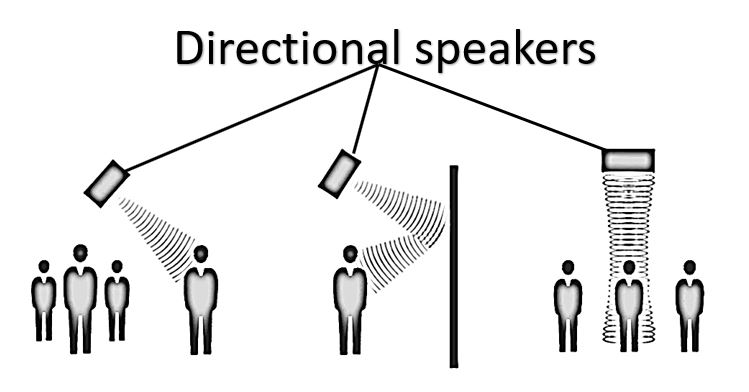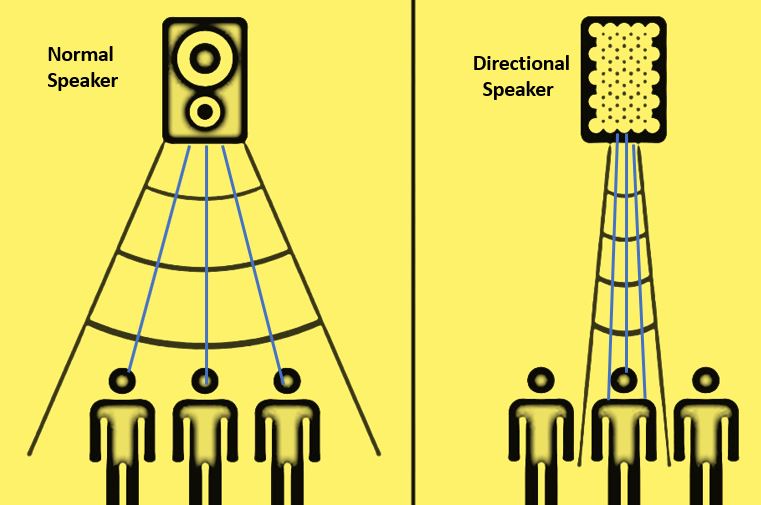Directional speakers can concentrate the sound only in one direction, and prevent it from spreading elsewhere like our normal multi-directional speakers.
When it comes to listening to our favourite music or watching our favourite shows in high quality, we have a number of options in hand. For high-quality audio, we have Dolby Digital, Dolby Atmos, and a number of other popular technologies, which can deliver life-like sounds that can make us feel, we are actually listening to those sounds in the real world. But even after all that, high-quality or high-intensity sounds can sometimes be a cause of irritation for us, and for others when we are enjoying a movie or TV show, but the people around you want complete silence.
Obviously, technology already has a solution for that, and, we can use our earphones and headphones for that purpose, but it is also a big headache to wear those big chunky pair of headphones, which will block all the ambient sounds that can sometimes be useful for us. What if we could have speakers that could generate sound so that only a person sitting in front of it can hear, and everybody around will experience complete silence! Yes, that is possible today, with a new technology that I will be talking about today, and they are directional speakers. Directional speakers can basically throw sound only in a single direction, targeting only that person who is supposed to listen to the sound. This is undoubtedly going to be another big boon for mankind in the world of Technology.
So, without any further delay, let’s get started with the concept of directional speakers, and the way such a technology can be useful in every sphere of life.
Before getting started with the concept of directional speakers, it will be worth knowing, how sound waves travel altogether, and the way, speakers create sounds that are audible to us.
What are the sound waves?
Sounds waves are actually compression and expansion of air particles at very fast speed. If air is made to compress and expand in a certain pattern, we can perceive that as a sound, or some form of music. Speakers do just that. In a speaker that we find within our sound systems or other electronic gadgets, comprises some major parts, the voice coil, magnet, and a cone that makes the vibration more precise, acting as a resonating body.
Whenever current is passed through the voice coil, a magnetic field is produced, which interferes with the magnet present inside the speaker. Attraction and repulsion take place due to the induced magnetic field by the voice coil and the magnet, which eventually create vibrations that are amplified by the cone to compress and expand the air, and we can hear sounds. Current is passed through the voice call in a way, that its vibration will create some form of music or sound that is audible to the human ears.
Eventually, when sounds are produced, they spread everywhere in a 3-dimensional area, just the way, ripples are produced when you throw stones in a pond. As the sound waves within a 3-dimensional area, everybody who can perceive the vibrations can also listen to the sounds, that actually happens in all directions. The faster the expansion and compression of sounds take place, the more is the frequency. Human ears can hear sound waves, which belong to the 200-20,000 hertz frequency range. Any frequency more or less than this range can be audible to certain animals, but not humans.
What is a directional speaker?
What if we could concentrate the sound only in one direction, and prevent it from spreading elsewhere. Exactly that is done in the case of directional speakers. It only sends sound to one-directional in which it would have been installed, thus the person standing in front of it can only listen to audio or music coming out of it.

How directional speakers work?
Unlike normal speakers, where there are basically, one, two, four or five drivers, directional speakers use an array of piezoelectric transducers, close to a few hundred or even more. These piezoelectric transducers, basically made from quartz, or something similar to that can vibrate at really high frequencies, beyond what humans can perceive. They can vibrate at two hundred thousand or 200,000 hertz, where human ears can only hear 200 to 20,000 hertz.
Because of the very high frequency of the waves produced by the piezoelectric transducers, they do not spread in all directions and can practically be considered to travel in a straight line. Now, in the case of directional speakers, the speakers, or basically the transducers produce a modulated sound, which consists of the reference frequency, which is 200,000 hertz that acts as a carrier wave, and another variable signal that vibrates between 200,200 and 220,000 hertz, which actually consist of the sound that the subject is supposed to hear.
Now, these two waves travel together, in a straight line, as long as it doesn’t face an obstruction. Once it collides with a physical body, like the human body, or the subject, who is supposed to hear the audio, the two waves interfere, both constructively as well as destructively, as per the principle of wave superposition.
If there’s a lot of scientific jargon, let me put things in a simpler way. When the two waves collide with our human body, the frequency of the waves is both added and subtracted at the same time. When it is added, the ultimate frequency lies somewhere between 400,200 and 420,000 hertz, and this range of audio frequency is inaudible to human ears. But on subtraction, the final frequency lies somewhere between 200 and 20,000 hertz, which is the sound that is supposed to be heard by us.
220,000 + 200,000 = 420,000 hertz (inaudible to humans, constructive interference)
220,000 – 200,000 = 20,000 hertz (audible to humans, destructive interference)
So that’s how directional speakers work. As there will be an array of over a hundred, or even more transducers, the sounds can be made to propagate very precisely, to make sure, the only person standing in front of the source can listen to it. As in the case of directional speakers, the sound waves do not propagate in multiple directions, sounds produced by directional speakers can also travel 15-20 times more than the sounds produced by normal speakers. The circuit responsible for making the sound should be smart enough to alter the frequency of the two sounds for making it conveniently audible to the human ear without much of a difficulty.

How can directional speakers change the way we hear sounds?
As directional speakers work in a completely different way, it has a lot of potentials to change the entertainment industry and the scopes of directional speakers are pretty huge, and it can also be used in defence to convey private messages in a simple way without making the civilians or others know about it. Let’s find out, how directional speakers can be implemented to deliver more convenience to mankind.
Advantages or implementations of DIrectional Speakers
Entertainment to a whole new level
As I discussed at the beginning of the article, directional speakers can make the sound audible to just the person sitting in front of the sound system, which means, you can experience true theatre experience, no matter where you are, completely hands free, without worrying about, the sound is irritating the people around you. With directional speakers at your home, office, mobile phone or tablet, you can listen to sounds, completely eradicating the worry of the sound on your device to disturb others.
By using the latest Bluetooth standards, which you can learn more about here, the controller can be paired with the user’s handset to allow the user to listen to music at any part of the house, depending upon the user’s presence in the house that can be tracked using Bluetooth. Implementing that might require a few hundred or even thousands of transducers, depending upon the size of the house, and might not be economically feasible for everybody. But the technology can be implemented.
Using some specialized motion sensors, the sound can also be made to reach the ears of a listener, if he is moving. With precise motion detection techniques, the transducers can also be made to move accordingly. Even though that will require tremendous developments of directional speakers, the same can at least be implemented.
Prologues at exhibitions, museums right into your ears
We often visit exhibitions and museums, where we come across some new elements, and the information about the same is transcribed or written somewhere close to it for our reference. But with directional speakers, audio can be played on repeat all the time right from behind the photos, or the respective element, and that will not be audible to people standing in other areas of the museum or exhibition room, but not in front of the element.
With a feedback mechanism, the music, or the prologue can also be made to play, when some actual person is standing in front of the same. This can eventually be helpful to move a step forward towards digital museums and exhibitions.
For defence and security
Using directional speakers, audio information can be sent to a certain group of people, without making the others know about it, at all. This can be a simple way to send important information for defence, however, it all requires more improvement, before it can actually be implemented for the purpose.
Sending audio information to an individual in a group
Using directorial speakers, audio information can be sent by activating the transducer(s) placed close to the person. This will eradicate the misuse of information, and also for the purpose of sending private information, which can’t thereby by sent, using regular speakers.
Future of directional speakers and current availability
After reading, I think, the potential or the capabilities of directional speakers is quite evident to you. The future is bright, undoubtedly. However, talking about the implementation of it, at the consumer level, we are yet to see the widespread availability of this cool technology! Sennheiser AudioBeam is one of the available directional speakers, which can be used in museums, theme parks, etc., and it comes with 150 piezoelectric transducers that can emit sounds in a single direction. Even though more research and development is necessary to make directional speakers a perfect piece of technology, other companies might already be contributing towards more development of the directional speakers.
So that was all about how directional speakers work, and how directional sound is produced with such speakers.
Related Posts
What is a juice-jacking attack? How can we be safe from such attacks?
Getting the right dashcam for your needs. All that you need to know
WhatsApp iPad App Gets Major Overhaul, Adds New Communities Feature
Moto G85 5G launched in India but is unlikely to beat VIVO or XIAOMI
Rise of deepfake technology. How is it impacting society?
Smartphone Apps Get Smarter- Meta AI’s Integration Across Popular Platforms